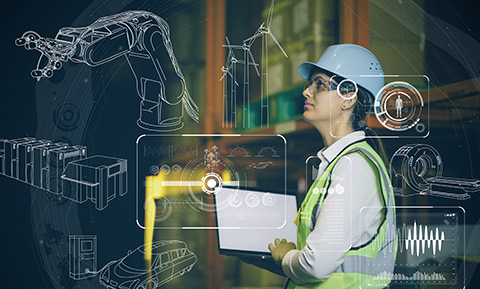We have reached the realm of Industry 4.0 where the manufacturing industry is undergoing successful bouts of digital transformation. This industry is by far top slotted in the market to be IoT realized and also where most of the industrial IoT investments are made. In the age of the fourth industrial revolution, IoT is a major component that is paving the way for the digital transformation of industries. According to a Million Insights report, the global Industrial Internet of Things market is predicted to reach $922.62 billion by 2025. The worldwide development and implementation of IoT have led to its growth in very few years.
Manufacturing IOT trends to watch out for by 2025

By making use of IoT in manufacturing, time consuming and manual operations are being phased
out with efficient business operations and better connectivity. In industries such as
manufacturing, healthcare and, transportation, IoT technology is used to connect machines
and devices thus leading to its increased efficiency.
There are several reasons why the manufacturing industry is a leading user of the Internet
of Things. Most of it is attributed to the next industrial revolution as well as use cases
and actual IoT deployments. These enable the manufacturers to realize digital
transformations. Some of the different perspectives from which this can be realized are
automation, customer-centricity, efficiency and the competitive benefits and the advantages
that are offered by making use of data across the manufacturing value chain. Take a look at
the top IoT trends in manufacturing and how efficiently it is being adopted in today’s
business.
Collaborative Robots
Did you know the early robots needed a lot of supervision and could perform only limited
tasks at a given time? Today, robots can not only perform multiple tasks simultaneously but
can also connect and interact with other robots. With this, a huge network of robots can be
created. Cobots is the name given to an entire network of collaborative robots.
Manufacturers that produce products on a large scale connects to a single production line of
cobots to assemble several product models. This ensures that there is no setup time and
reconfiguration issues and also stick to the scheduled production time. Collaborative robots
are also adept at producing customized products and can swiftly handle dangerous tasks that
might otherwise prove to be a risk for the human workforce.
Augmented Reality
Augmented reality (AR) works by placing a layer of digital content over the world as we see
it. This is quite different from virtual reality which entirely replaces a human’s vision
with a virtual environment.
Car manufacturers are making use of AR to improve and stabilize the end-user experience. It
also helps in enhancing the safety levels. This is how it works; the speed meter and the
radio station are displayed using AR to appear as if it’s hovering over the hood of the car.
Drivers will never face any difficulty in tracking the speed of the car nor in finding out
which music track they are listening to, as they do not have to take their eyes off the
road.
When it comes to workers, AR can be applied for repairs, maintenance as well as other
functionalities. Working in concurrence with IoT, AR can be used to get real-time
information to detect problems as well as receive detailed descriptions of repair before
setting out to work on it.
Edge Computing
Even though edge computing is not relatively a new technology, it is now gaining momentum among the manufacturers. Edge computing is a technology that can take on huge data sets like information which are collected through several numbers of sensors within the factory. Further on it can produce outputs that comprise of actionable and insightful data. Apart from this, edge computing also assists in reducing the costs of Wide Area Network (WAN) as well as its traffic and latency. This is achieved by keeping the data and information’s collection and its processing quite close to its source.
Digital Twins
As per a recent report, by 2020 it is estimated that more than 20 million digital twins will
exist for billions of things. A digital twin is a representation of a physical object or a
system. Real-time data and analytics together have made digital twins stronger and flexible
in the real world. It has been predicted that eventually, digital twins will help the
manufacturing plants to move forward from preventive maintenance to condition-based or
predictive maintenance. This, in turn, will help in lowering the downtime costs as well as
operational maintenance costs.
Digital twin and industrial IoT together represent a major change in manufacturing. A
Digital twin can be considered as a live model that can be put into effect in several ways
within the manufacturing sector. On a high scale, IoT digital twins allow us to analyze
production decisions based on analytics, visualize the products that are being used in
real-time, reduce service costs by commissioning machines from the remote service centre,
connect several different processes for improving the tracking and monitoring, reduce
incident resolution time by troubleshooting equipment in remote locations and gain a
strategic control over complex processes and systems.
RFID Tags
Radio-frequency Identification (RFID) tags can be attached to a wide variety of things and
can also be made invisible to see through human eyes. RFID tags can be used to track and
monitor assets and product data to keep a tab on its performance. This data can be used for
predictive maintenance.
Another important functionality of RFID tags is that they can be used to create customer
experiences that are engaging. For example, a reusable water company installed RFID tags in
its bottles. When customers refill their bottles at the water fountain, the scanner reads
the tag and provides feedback which is personalized. Some of this would be the amount of
water consumed by the user and much more such feedback.













